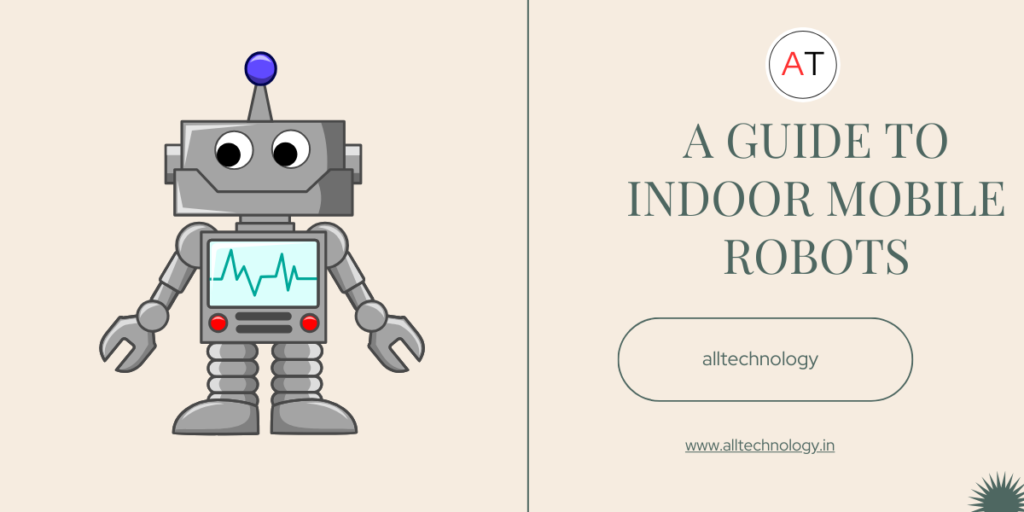Introduction
Hello Bloggers welcome alltechnology blog. In this blog you will learn A Guide to Indoor Mobile Robots So friends, I have given a lot of information in this blog post, if you liked my information then please let me know.
Robots often struggle with navigation in dynamic environments, suffer from limited battery life, and depend heavily on robust communication networks. Achieving reliable performance in varied and unstructured indoor settings remains a daunting challenge.

Applications of Indoor Mobile Robots
Indoor mobile robots are transforming various sectors by automating complex tasks and enhancing service efficiency. These intelligent systems adapt to diverse environments, proving essential for mundane and interactive roles alike.
As the use of indoor mobile robots increases, so do ethical and social concerns, including potential job displacement, privacy issues, and an over-reliance on automation. These issues demand thorough consideration of the societal impacts and the formulation of appropriate policies and regulations to ensure responsible use of these technologies.
Latest Research and Developments Recent research and development in indoor mobile robotics are primarily focused on enhancing robot autonomy, operational efficiency, and interactive capabilities. These advancements are concentrated on refining the technological frameworks and algorithms that support these systems, aiming to ensure more precise and reliable functionalities in complex environments.
One algorithm leverages visual and LiDAR data to create highly detailed and precise indoor maps, effectively handling environments with poor lighting or complex structures. The enhanced SLAM system enables robots to execute tasks with increased precision and reliability.
In another study published by IEEE, researchers introduced a software architecture designed for real-time human tracking in manufacturing environments.
This system utilizes the You Only Look Once (YOLOv8) computer vision model to facilitate human pose estimation and target identification, drawing on 3D information captured by stereo cameras. Upon identifying the desired target, the action system orchestrates the robot’s movements through the Robot Operating System (ROS).
Experimental trials with physical robots have demonstrated the architecture’s feasibility and effectiveness in boosting operational efficiency in manufacturing settings.
Furthermore, a study featured in the journal Machines addressed challenges such as adapting to dynamic environments and managing ambiguous identifications.
The researchers developed a service robot equipped with deep learning algorithms for precise small-object recognition, autonomous path planning, and obstacle avoidance capabilities. This robot has exhibited high performance and accuracy in various indoor settings.
Robotics Market Forecast to Grow at 16.60% CAGR from 2024 to 2031 | SkyQuest Technology
Download a detailed overview: https://www.skyquestt.com/sample-request/robotics-market Robots Taking Over Industrial and Service-based Applications Industrial applications are projected to utilize robotics technology like no other sub-segment. Growing emphasis on improving the operational efficiency and productivity of industrial establishments is projected to promote the adoption of robotics in this sub-segment and allow it to bring in the most revenue.
From material handling to process optimization, robotics can revolutionize almost all industrial applications to maximize profitability for industries. Robots can also help automate repeated tasks to optimize resource utilization. Robots are being extensively used in assembly and inspection applications in industries thereby creating a bright outlook for robotics market players.
Use of robotics to provide services is also estimated to increase over the coming years as the acceptance of robots in service-oriented businesses rises.
Delivery, cleaning, sanitation, harvesting, catering, and many other services can be delivered through robots. Increasing use of robotics in customer service is also projected to help this sub-segment bolster the global robotics market growth in the future.
Request Free Customization of this report: https://www.skyquestt.com/speak-with-analyst/robotics-market From Factories to Entertainment, Robots are Everywhere Modernization and automation of different manufacturing operations allow manufacturing end-users to lead the demand for robotics around the world. High availability and acceptance of advanced robots to optimize productivity and eliminate errors is what helps promote robotics adoption in the manufacturing sub-segment. Digitization of the healthcare industry is projected to create an opportune scenario for robotics adoption.
Growing emphasis on creating more precise and advanced robots that can replicate the surgical precision offered by seasoned medical professionals is slated to help the healthcare end-user bolster robotics market development in the future. The rising popularity of unmanned aerial vehicles (UAVs) and autonomous drones is projected to bolster the demand for robotics technology in aerospace and defense sub-segments across the forecast period and beyond.
High investments in aerospace and defense R&D are also predicted to help this sub-segment uplift the demand for robotics in the future. Story continues Media and entertainment robotsas end-usersare used for delivering performances and creating stunning visual displays for the audience. Robotics is projected to change the entire media and entertainment industry in the future ranging between robotic cameras with efficient capturing abilities to robotic stunt doubles for better viewing experience.
Robot sales in North America dip 6% in Q1
It should be noted A3 only collects sales data on traditional industrial robots. It doesn’t collect data about autonomous mobile robots or collaborative robotic arms. While overall orders decreased during Q1 2024, orders from non-automotive companies grew 16% over Q1 2023, A3 said. Non-automotive customers ordered 4,096 robots in Q1 2024, which accounted for 48% of total orders. Among these customers, the greatest growth in orders between Q1 2023 and Q1 2024 was seen in: Food & consumer goods: 120% Life sciences, pharmaceutical & biomedical: 72% Metals: 46%
Conclusion
The robotics market has a lot of scope to expand across multiple industry verticals thereby pushing robotics companies to keep innovating and launching new products. Advancements in robotics and the growing popularity of robotic process automation are also forecasted to augment the global robotics demand outlook in all segments. New companies should target the manufacturing end-user segment to penetrate the market and compete with established market players. Whereas, established robotics providers should emphasize innovation and target the aerospace and defense sub-segment.
